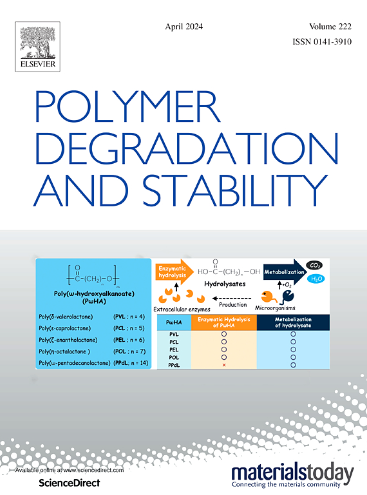Bioinspired tannic acid-based adhesive with hyperbranched polymer and nano-Mg(OH)2 hybrids for high-performance, flame-retardant, and sustainable plywood
IF 7.4
2区 化学
Q1 POLYMER SCIENCE
引用次数: 0
Abstract
The development of innovative biomass-based, flame-retardant plywood is set to overcome the dual technical barriers of formaldehyde emissions from conventional resin systems and the inherent flammability of wood. Creating sustainable adhesives to replace hazardous formaldehyde-based resins represents an urgent need in material science, tackling current limitations in eco-friendly alternatives that balance high performance with multifunctionality. Stepping into the structural shoes of marine arthropod cuticles as an inspiration, this study employed the Schiff base/Michael addition reaction to covalently cross-link oxidized tannins with amino-functionalized hyperbranched polymers and Mg(OH)2![]() NH2 nanohybrids to design a bio-based adhesive system. Comprehensive characterization through mechanical testing (dry/wet adhesion strength), flame retardancy evaluation (Limiting Oxygen Index (LOI) and Cone Calorimeter-Based Thermal Analysis), and thermal analysis demonstrated that the hierarchical particle-chain structure demonstrates a commendable dry strength of 1.52 MPa, while exhibiting 88 % retention in 63 °C water and 70 % in boiling water, along with excellent flame resistance and robust thermal stability. The phenolic-amine synergistic system improved interfacial adhesion, crosslinking density, and flame retardancy through covalent bonding, gas-phase radical quenching, and char-layer barrier mechanisms. This biomimetic design establishes a circular economy paradigm for converting natural polyphenols into multifunctional adhesives, providing theoretical insights into dynamic covalent networks and scalable solutions for eco-friendly wood composites.
NH2 nanohybrids to design a bio-based adhesive system. Comprehensive characterization through mechanical testing (dry/wet adhesion strength), flame retardancy evaluation (Limiting Oxygen Index (LOI) and Cone Calorimeter-Based Thermal Analysis), and thermal analysis demonstrated that the hierarchical particle-chain structure demonstrates a commendable dry strength of 1.52 MPa, while exhibiting 88 % retention in 63 °C water and 70 % in boiling water, along with excellent flame resistance and robust thermal stability. The phenolic-amine synergistic system improved interfacial adhesion, crosslinking density, and flame retardancy through covalent bonding, gas-phase radical quenching, and char-layer barrier mechanisms. This biomimetic design establishes a circular economy paradigm for converting natural polyphenols into multifunctional adhesives, providing theoretical insights into dynamic covalent networks and scalable solutions for eco-friendly wood composites.
生物启发单宁酸为基础的粘合剂,具有超支化聚合物和纳米mg (OH)2混合物,用于高性能,阻燃和可持续胶合板
创新的生物质阻燃胶合板的开发旨在克服传统树脂系统甲醛释放和木材固有可燃性的双重技术障碍。创造可持续的粘合剂来取代有害的甲醛基树脂代表了材料科学的迫切需要,解决了目前在平衡高性能和多功能的环保替代品方面的限制。本研究以海洋节肢动物角质层的结构为灵感,采用希夫碱/迈克尔加成反应,将氧化单宁与氨基官能化超支化聚合物和Mg(OH)2NH2纳米杂化物共价交联,设计了一种生物基胶粘剂体系。通过力学测试(干湿粘接强度)、阻燃性评估(极限氧指数(LOI)和基于锥量热计的热分析)和热分析,综合表征表明,分层颗粒链结构具有令人称赞的干强度1.52 MPa,在63°C水中和沸水中分别具有88%和70%的保留率,同时具有优异的阻燃性和强大的热稳定性。酚醛-胺协同体系通过共价键、气相自由基猝灭和炭层阻隔机制改善了界面附着力、交联密度和阻燃性。这种仿生设计建立了将天然多酚转化为多功能粘合剂的循环经济范例,为生态木复合材料的动态共价网络和可扩展解决方案提供了理论见解。
本文章由计算机程序翻译,如有差异,请以英文原文为准。
求助全文
约1分钟内获得全文
求助全文
来源期刊

Polymer Degradation and Stability
化学-高分子科学
CiteScore
10.10
自引率
10.20%
发文量
325
审稿时长
23 days
期刊介绍:
Polymer Degradation and Stability deals with the degradation reactions and their control which are a major preoccupation of practitioners of the many and diverse aspects of modern polymer technology.
Deteriorative reactions occur during processing, when polymers are subjected to heat, oxygen and mechanical stress, and during the useful life of the materials when oxygen and sunlight are the most important degradative agencies. In more specialised applications, degradation may be induced by high energy radiation, ozone, atmospheric pollutants, mechanical stress, biological action, hydrolysis and many other influences. The mechanisms of these reactions and stabilisation processes must be understood if the technology and application of polymers are to continue to advance. The reporting of investigations of this kind is therefore a major function of this journal.
However there are also new developments in polymer technology in which degradation processes find positive applications. For example, photodegradable plastics are now available, the recycling of polymeric products will become increasingly important, degradation and combustion studies are involved in the definition of the fire hazards which are associated with polymeric materials and the microelectronics industry is vitally dependent upon polymer degradation in the manufacture of its circuitry. Polymer properties may also be improved by processes like curing and grafting, the chemistry of which can be closely related to that which causes physical deterioration in other circumstances.
 求助内容:
求助内容: 应助结果提醒方式:
应助结果提醒方式:


